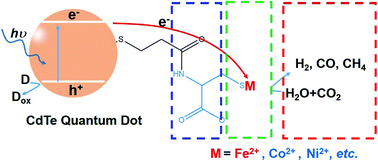Our official English website, www.x-mol.net, welcomes your
feedback! (Note: you will need to create a separate account there.)
Immobilization of catalytic sites on quantum dots by ligand bridging for photocatalytic CO2 reduction.
Nanoscale ( IF 5.8 ) Pub Date : 2020-01-13 , DOI: 10.1039/c9nr09321d Yipeng Bao 1 , Jin Wang 1 , Qi Wang 1 , Xiaofeng Cui 2 , Ran Long 3 , Zhengquan Li 1
Nanoscale ( IF 5.8 ) Pub Date : 2020-01-13 , DOI: 10.1039/c9nr09321d Yipeng Bao 1 , Jin Wang 1 , Qi Wang 1 , Xiaofeng Cui 2 , Ran Long 3 , Zhengquan Li 1
Affiliation

|
Harvesting solar energy to convert carbon dioxide (CO2) into fossil fuels shows great promise to solve the current global problems of energy crisis and climate change. To achieve this goal, it is desirable to develop efficient catalysts with visible light response to cater for the solar spectrum. CdTe QDs are ideal candidates for absorbing visible light, but it is difficult to directly perform CO2 reduction due to the lack of effective catalytic sites. Herein, we report a strategy for the activation of mercaptopropionic acid (MPA)-capped CdTe QDs for visible-light-driven CO2 reduction, in which iron ions (Fe2+) are immobilized onto CdTe QDs using l-cysteine as a bridging ligand (CdTe-b-Fe). This ligand bridging strategy can immobilize Fe2+ ions on the surface of CdTe QDs as catalytic sites, and these catalytic sites can be conveniently adjusted by directly adding different types or numbers of metal ions. In addition to effectively immobilizing catalytic sites, the bridging ligands can also provide a pathway for electron transport between CdTe QDs and the catalytic sites. The CdTe-b-Fe QD system based on the ligand bridging strategy exhibits excellent catalytic properties: the yield of CH4/CO (two products together) is 126 μmol g-1 h-1, and the selectivity for carbon-based products approaches 98%. This work presents a facile strategy for immobilizing catalytic sites on QDs and provides a platform for designing efficient visible-light driven catalysts for CO2 reduction.
中文翻译:

通过配体桥接将量子点上的催化位点固定化,以进行光催化CO2还原。
收集太阳能将二氧化碳(CO2)转换为化石燃料显示出解决当前全球能源危机和气候变化问题的巨大希望。为了实现该目标,期望开发具有可见光响应以迎合太阳光谱的有效催化剂。CdTe QD是吸收可见光的理想候选物,但是由于缺乏有效的催化部位,很难直接进行CO2还原。在本文中,我们报告了一种激活巯基丙酸(MPA)的CdTe QD用于可见光驱动的CO2还原的策略,其中使用L-半胱氨酸作为桥联配体(CdTe)将铁离子(Fe2 +)固定在CdTe QD上-b-Fe)。这种配体桥联策略可以将Fe2 +离子固定在CdTe QD的表面上作为催化位点,通过直接添加不同类型或数量的金属离子,可以方便地调节这些催化部位。除有效固定催化位点外,桥联配体还可为CdTe QD和催化位点之间的电子传输提供途径。基于配体桥联策略的CdTe-b-Fe量子点系统表现出出色的催化性能:CH4 / CO(两种产物在一起)的产率为126μmolg-1 h-1,对碳基产物的选择性接近98 %。这项工作提出了固定QDs上催化部位的简便策略,并为设计有效的可见光驱动的催化剂以减少CO2提供了平台。桥联配体还可以为CdTe QD和催化位点之间的电子传输提供途径。基于配体桥联策略的CdTe-b-Fe量子点系统表现出出色的催化性能:CH4 / CO(两种产物在一起)的产率为126μmolg-1 h-1,对碳基产物的选择性接近98 %。这项工作提出了固定QDs上催化部位的简便策略,并为设计有效的可见光驱动的催化剂以减少CO2提供了平台。桥联配体还可以为CdTe QD和催化位点之间的电子传输提供途径。基于配体桥联策略的CdTe-b-Fe量子点系统表现出出色的催化性能:CH4 / CO(两种产物在一起)的产率为126μmolg-1 h-1,对碳基产物的选择性接近98 %。这项工作提出了固定QDs上催化部位的简便策略,并为设计有效的可见光驱动的催化剂以减少CO2提供了平台。
更新日期:2020-01-13
中文翻译:

通过配体桥接将量子点上的催化位点固定化,以进行光催化CO2还原。
收集太阳能将二氧化碳(CO2)转换为化石燃料显示出解决当前全球能源危机和气候变化问题的巨大希望。为了实现该目标,期望开发具有可见光响应以迎合太阳光谱的有效催化剂。CdTe QD是吸收可见光的理想候选物,但是由于缺乏有效的催化部位,很难直接进行CO2还原。在本文中,我们报告了一种激活巯基丙酸(MPA)的CdTe QD用于可见光驱动的CO2还原的策略,其中使用L-半胱氨酸作为桥联配体(CdTe)将铁离子(Fe2 +)固定在CdTe QD上-b-Fe)。这种配体桥联策略可以将Fe2 +离子固定在CdTe QD的表面上作为催化位点,通过直接添加不同类型或数量的金属离子,可以方便地调节这些催化部位。除有效固定催化位点外,桥联配体还可为CdTe QD和催化位点之间的电子传输提供途径。基于配体桥联策略的CdTe-b-Fe量子点系统表现出出色的催化性能:CH4 / CO(两种产物在一起)的产率为126μmolg-1 h-1,对碳基产物的选择性接近98 %。这项工作提出了固定QDs上催化部位的简便策略,并为设计有效的可见光驱动的催化剂以减少CO2提供了平台。桥联配体还可以为CdTe QD和催化位点之间的电子传输提供途径。基于配体桥联策略的CdTe-b-Fe量子点系统表现出出色的催化性能:CH4 / CO(两种产物在一起)的产率为126μmolg-1 h-1,对碳基产物的选择性接近98 %。这项工作提出了固定QDs上催化部位的简便策略,并为设计有效的可见光驱动的催化剂以减少CO2提供了平台。桥联配体还可以为CdTe QD和催化位点之间的电子传输提供途径。基于配体桥联策略的CdTe-b-Fe量子点系统表现出出色的催化性能:CH4 / CO(两种产物在一起)的产率为126μmolg-1 h-1,对碳基产物的选择性接近98 %。这项工作提出了固定QDs上催化部位的简便策略,并为设计有效的可见光驱动的催化剂以减少CO2提供了平台。











































 京公网安备 11010802027423号
京公网安备 11010802027423号